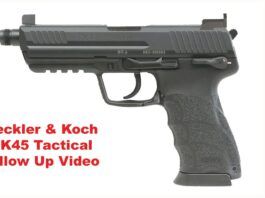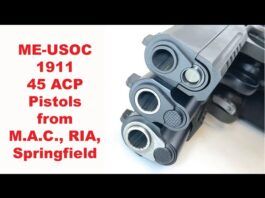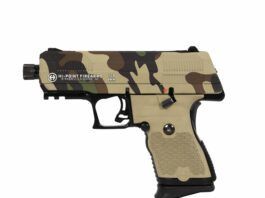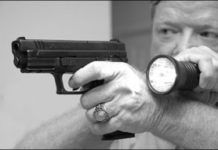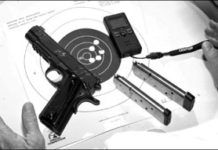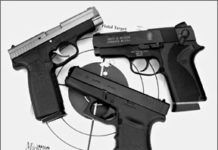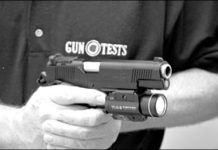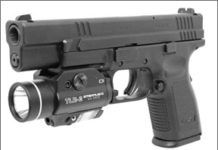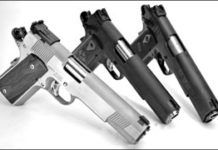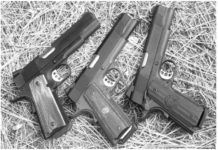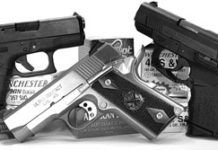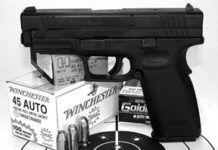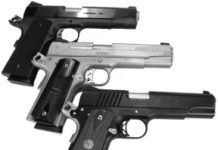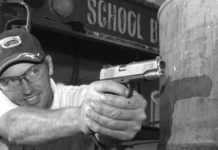45 ACP Polymer Pistols with Thumb Safeties: Buy the XD45
.45 ACP Matchup: Were Mostly Sold on Kimbers Custom SIS RL
In this evaluation, we will look at three .45 ACP 1911-style pistols. Not too long ago, this would mean three pistols that looked almost exactly alike. But today's 1911 may contain as many different components as the total number of its parts. For example, the new Brownells catalog devoted solely to the 1911 lists as many as 27 different styles of custom hammers. Thus, our test guns offered several different variations on the 1911 platform.
Our three test guns were the $1421 Kimber Custom SIS RL, Springfield Armory's $1332 Loaded Operator MC, and the $1129 Para Ordnance P14-45S GR. Each gun fired from a 5-inch barrel supported at the muzzle by a bushing and could be referred to as full-size "Government" models. But the Para Ordnance pistol offered higher capacity, feeding from a wider magazine wherein the rounds were piled in a zigzag pattern rather than stacked in a single column. All three guns varied in the designs of their grips, sights, and thumb safeties.
Full-Size Polymer .45s: S&Ws M&P45 Beats H&K and Glock
Gun Tests readers sometimes ask why reviews on certain guns vary over time. For instance, they wonder why Gun A, reviewed two years ago, got a "Don't Buy" rating, but in a more recent evaluation, it gets a B+. The short answer is that test to test, guns vary, ammunition varies, the story angle varies, and, perhaps most important, the match-ups vary. In an earlier draw, Gun A may have run up against other models that made it look like chopped liver. Then when we tested it again, Gun A may have whipped Guns B and C because the latter two weren't much good, and Gun A benefited from the comparison.
In a way, that's what happened when we tested a new-for-2007 Smith & Wesson M&P 45 .45 ACP, $619, against a $1235 Heckler & Koch USP Compact Tactical USP45CT .45 ACP, which we last tested in June 2007, and the $635 Glock 21 SF, which we tested in July 2007. In June, the H&K got an "A" rating, when we said its "…light weight, ease of maintenance, and accuracy makes it very appealing. Our staff concluded that it was best to operate the USP45CT either as a full-time single-action pistol or a full-time TDA. Sticking with one system or the other was the only way to stay trained up, in our opinion."
Likewise, the Glock 21 SF got kudos from us as well, when we said in July, "No question this is an improvement on the G21. Better handling, but still a big gun with little potential for concealed carry. In our view, we think police will be trading in their G21s for the improved SF model."
First introduced by S&W in February 2007, the M&P45 is the newest addition to the M&P pistol series, a product line launched in December 2005. We've tested the M&P9 9mm and the M&P40 with varying degrees of success, rating the Smith & Wesson M&P 9mm Compact 2009004, $624, as a "D" in the April 2007 issue. The Smith & Wesson M&P .40 S&W No. 209000, $624, got a "Conditional Buy" in the August 2006 issue, and a Smith & Wesson M&P40 .40 S&W, $495, got an "A-" in the October 2007 issue.
The M&P45 began shipping in May 2007. Leland Nichols, president and COO of Smith & Wesson Corp., said at the time, "By combining the powerful .45 ACP cartridge with the performance and safety features of the M&P series, working professionals and shooting sports enthusiasts have a new option in the growing line of M&P products well-suited to fulfill a variety of needs."
Nichols continued, "We are also aware that multiple branches of the U.S. Military have expressed a desire to shift from their current 9mm weapons to either a .40 or .45 caliber duty weapon for greater stopping power. We are now currently shipping both .40 and .45 calibers, as well as a 9mm, in the M&P Pistol Series, and are fully prepared to address either requirement, should the U.S. Military initiate a request for purchase."
The gun was rolled out as a full-size polymer pistol with a 10+1 magazine capacity and an optional 14+1 magazine. It was originally offered with a traditional black frame and was manufactured with or without a frame-mounted ambidextrous thumb safety. Later, the M&P45 came with a dark earth-brown frame and a standard manual thumb safety, which is the gun we acquired for this test.
.45 ACP Single-Stack Pistols: S&W Pulls Out a Surprise Win
Full-Sized Tactical .45s With Accessory Rails: Buy the TRP
Versatile Polymer .45s: Two XD45 Compacts Are Our Picks
In this test we will look at four different polymer handguns that offer higher round capacity but take up less space than full-size models. Our first pistol, the $503 Taurus PT24/7 Pro 45-BP-12 could be considered a true compact, especially when compared to Taurus's new OSS pistol. The Springfield Armory XD45 4-inch Compact XD9645HCSP06, $589; and the Springfield Armory XD45 5-inch Compact Tactical XD9655HCSP06, $619, have undergone the Colt Officers treatment, receiving a shortened grip frame attached to a full-length slide. The $637 Glock SF21 is a remodeling of the Glock 21, but the SF21 does not seem to be much smaller. We wanted to find out if any of its subtle streamlining added up to a better pistol than the original.
We established basic accuracy for each pistol by measuring five-shot groups fired from a rest at 15 yards. Our test ammunition consisted of a typical practice round, Winchester's 230-grain FMJ Q4170 load and two hollowpoint defense rounds. Our JHP rounds were Winchester's USA45JHP ammunition and the Hornady Custom 185-grain JHP/XTP No. 9090 load. In terms of accuracy all three guns exceeded our expectations.
We also put the guns through an action-shooting test in which the operator pressed the trigger as fast as he could confirm an acceptable sight picture. For this test we visited American Shooting Centers in Houston (amshootcenters.com). There, we posted a Hoffners ABC16 target at the 7-yard line. This target measured a full 35 inches tall by 23 inches wide with six 3-inch aiming circles on each side of a humanoid silhouette. We fired 10 three-shot strings at the silhouette for a total of 30 rounds. The first two shots were aimed at the 5.5-by-8.0-inch A-zone chest area. The third shot was aimed at the B-zone, represented by a 5-inch-diameter half circle in the head. Firing from the bench at a 1.5-inch bull and unsupported at the Hoffners target were simple but revealing tests. Here is what we learned about each pistol.
Basic 1911 .45s: Dan Wessons Pointman Seven Leads the Way
High-Dollar 1911s: Wilson CQB Beats Nighthawk, Rock River
Subcompact Power: .45 ACP, .40 S&W, and .357 SIG Guns
Recently we received a letter from a subscriber who asked us to compare a small .45 ACP 1911 pistol to some of today's more popular options in the category of subcompact pistols. Keynotes of comparison were action design, similar size, and similar stopping power. Also, our reader wanted us to compare the speed and integrity of fundamental controls other than the trigger. A concealed-carry gun may never be reloaded during a confrontation, but you wouldn't want to drop the magazine by accident or fumble releasing the slide.
Your competition or hunting gun may be the love of your life but a powerful subcompact pistol is the one you are likely to spend the most time with. In this test we'll get up close and personal with three pistols small enough to blend in with your lifestyle and powerful enough to preserve it. The Springfield Armory Ultra Compact 1911A1 PX9161L, $952, represents the traditional .45 ACP single-action single-stack pistol. The Glock polymer pistol is another very popular option. The Glock 33 No. PI3350201, $599, is chambered for .357 SIG, which offers .357 Magnum power in a controllable high-capacity platform. Smith & Wesson's SW990L in .40 S&W is also a polymer pistol with a double-column magazine, but distinguishes itself from the Glock pistol by utilizing a Walther design. Our SW990L No. 120233, $729, like the others, employed approximately a 3.5-inch barrel, and all three were specifically designed for concealed carry.
New Semi-Auto Power Pistols: Springfields XD 45 Is A Winner
Two recent pistol introductions have been much-ballyhooed in the gun press and firearms industry: Springfield's XD 45 and the Smith & Wesson M&P 40. At the NRA annual meetings in Milwaukee May 19-21, the new XD pistol in .45 ACP won Handgun of the Year notice from NRA's American Rifleman magazine, and it won Handgun of the Year at the Shooting Industry Academy of Excellence awards. The S&W M&P .40 was likewise nominated for the Shooting Industry award, and another NRA publication, Shooting Illustrated, named the M&P as its 2006 Handgun of the Year.
Because interest seems high, we wanted to weigh in on which pistol we thought was the best, so we acquired a $559 Springfield Armory XD (Extreme Duty), and a $624 Smith & Wesson M&P (Military and Police) pistol. Of course, both were designed to provide an effective weapon for law enforcement and military use, but they certainly will serve as personal defense guns for civilians that are durable, easy to maintain and within most budgets.
The XD is based on the Croatian police sidearm that Springfield Armory has adapted to the American market. Chambering the XD for .45 ACP is the latest volley aimed at landing the XD in the holster of every policeman. The XD is a proven design, but we wondered how the power and size of .45 ACP ammunition would affect the integrity of the machine as well as the friendly ergonomics that have attracted so many buyers in other chamberings. The Smith & Wesson M&P 40 S&W is the result of research and development that included consultation with the law enforcement and military training community. Starting with a clean slate, Smith & Wesson has risked much more than Springfield Armory by having to spend money on tooling up. Was it worth the investment?
A Fresh Crop of Full-Size 1911s: We Choose the Para-Ord SSP
In this review we will evaluate three 1911 45 ACP pistols relatively new to the market. Each one was manufactured by names first associated with pistols other than the single-stack Browning design. For instance, Para-Ordnance is a Canadian firm most famous for introducing high capacity to the 1911 by enlarging the receiver to house a double-column magazine. STI International is known for its modular design melding a polymer grip to a set of rails to produce a high capacity pistol also fed from a double stack magazine. Sigarms has been making a single stack .45 for many years, the P220. But the P220 is closer to Browning's BDA design, operating with a traditional double-action trigger. Sigarms's single-action gun, the GSR Revolution, costs $1,049 and this puts it squarely between the $1,344 STI Lawman 5.0 and the $899 Para-Ordnance SSP.
We began our tests by removing the top ends of each gun and making sure they were properly lubricated. All three guns were function fired with a variety of ammunition left over from other tests, then loaded with at least 200 rounds of a handload featuring the 200-grain lead-swaged bullet from Precision Bullets (www.precisionbullets.com) that offered molybdenum coating to minimize deposits. Alliant Power Pistol smokeless powder was the propellant, ignited by Winchester large primers. We recorded accuracy data at an outdoor range from a 25-yard bench rest with this round plus three factory loads. They were 200-grain +P Speer Gold Dots, Federal's 165-grain Hydra-Shok JHP rounds, and the Atlanta Arms and Ammo 185-grain JHP match ammunition, (www.atlantaarmsandammo.com). This is the same load used by the United States Army Marksmanship Unit, (AMU). Our test team members believed that any full-size gun in this price range should deliver five-shot groups measuring approximately 2.5 inches or less and run without any problems. Let's see how these new .45s did when examined by our critical group of shooters:
Lightweight .45s: The Bi-Tone Looks Great and Shoots Great
In this report the Smith & Wesson 1911SC will be matched head to head with Springfield Armory's Service Model 5-inch Lightweight Bi-Tone pistol. We will also reflect upon our recent test of the Kimber Tactical Custom II and bring our findings of the three pistols up to date. The ammunition used to test-fire the Springfield Armory and Smith & Wesson pistols was the same selection used in our test of the Kimber published in the November 2005 issue. The Kimber was re-chronographed along with our current two pistols to account for the change in temperature between test dates. consisted of Winchester's 230-grain FMJ and JHP rounds plus 185-grain JHP rounds from Black Hills Ammunition. Test distance was once again 25 yards from a bench rest. Since each of our guns was priced above $900 MSRP, we expected tight groups without malfunctions or breakage. If each gun came through as expected would we be able to make a clear choice? Only the shooting will tell.





























